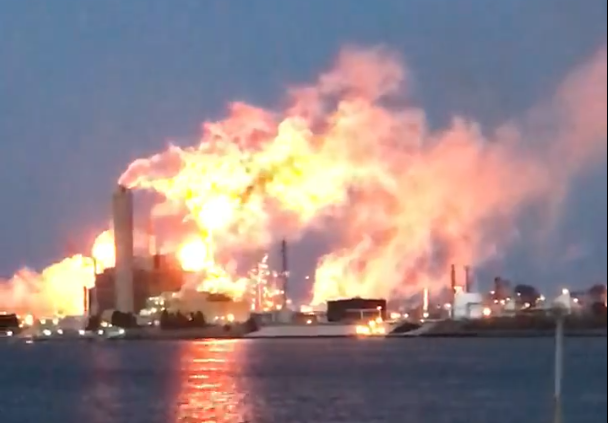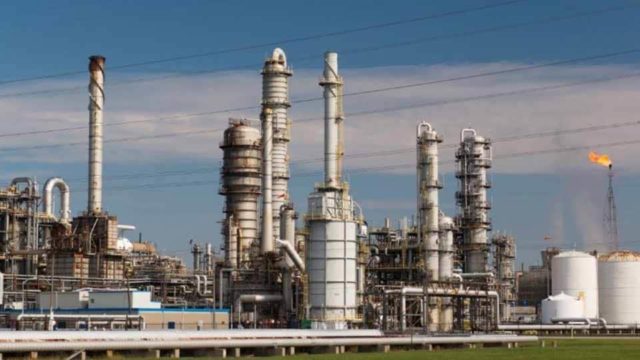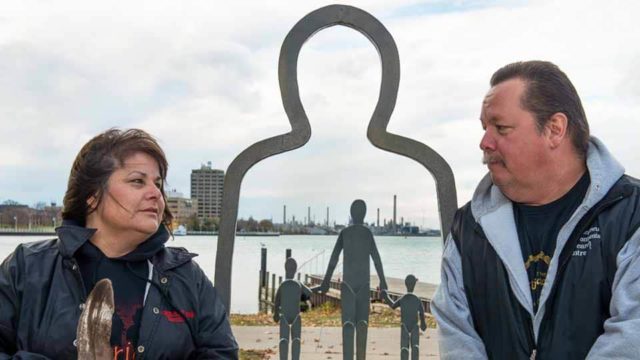Imagine seeing extreme flaring down the road from your home on an otherwise quiet Thursday evening.
You and your neighbours closest to Imperial Oil’s refinery feel your windows shaking. Outside, there is an audible roar of flames rocketing from flare stacks, filling the sky with dark plumes of smoke and pungent vapour. People are scared – some fearing for their lives, not knowing whether the refinery is going to explode.
This is an example of “flaring” — when an industrial facility, such as a petroleum refinery or petrochemical plant, burns off excess gases. Flaring is often used to burn off gases that could create a dangerous situation or explosion. Usually, flaring is prompted by an accident that requires a unit be depressurized, or during regular start-up or shut-down of all or part of a refinery for maintenance. Sometimes, a shut down is required when the seasons (and consequently the the type of fuels produced) change.
Now imagine that flaring events are so common in your community, that they are normalized.
Welcome to Canada’s Chemical Valley, located just outside Sarnia, Ontario.
Rather than apologizing for an accident that lit up 50 kilometres of sky, Imperial Oil initially responded by refusing to confirm it was their refinery depicted in videos shared by concerned residents on social media. Imperial Oil later described the incident as a mere “mechanical issue” that resulted in “some visible flaring.” An industry association representative downplayed the flare as an “optical illusion.”
In an update from Imperial Oil to the nearby Aamjiwnaang First Nation, the company notified residents they could expect to see flaring in the coming days while it restarted units affected by the “operational issue.” Instead, the flaring continued for over a week.
Residents were (and are often) given little clarity on what chemicals are released in flares, whether they will affect the health of their families, or what the government will do to address the incident. According to statements from Imperial Oil, there were no dangerous chemicals released into the community’s air. Although there was at least one fire reported at the time on land near the flares, the company announced there was no off site damage.
It’s hard to imagine, but this is the peculiar reality faced by Aamjiwnaang First Nation and other communities in close proximity to the cluster of petrochemical facilities in “Chemical Valley.”
How does Ontario measure up?
While flaring may be necessary to avoid a catastrophic event, it should be a very rare occurrence and not accepted as a normal part of operating a refinery. Extremely high flaring should never be tolerated unless it is to avoid a much worse scenario such as an explosion. Compared to chemical plants and petroleum refineries in countries including the United States, United Kingdom, Australia and Norway, facilities in Ontario are subject to less stringent requirements to identify and prevent malfunctions. For instance, the U.S. has benefitted from the Chemical Safety Board, an independent agency that investigates industrial chemical accidents and makes recommendations to companies, labour groups, and regulatory agencies to prevent future accidents to promote worker and public safety. The U.S. EPA requires flare monitoring and has taken steps to virtually eliminate flaring related to malfunctions and accidents.
Ontario must improve its oversight of the safety of chemical plants and refineries in Ontario to reduce the number of malfunctions that ultimately lead to flaring. In lieu of proper maintenance, plant upgrades, and technology to limit shut-downs and the adoption of alternative technologies that prevent flaring and manage excess gases during malfunctions, flaring continues as an acceptable practice at many Chemical Valley facilities.
Not only is flaring dangerous, it contributes to unnecessary pollution and greenhouse gas emissions by burning off gases that could be used as a source of energy. Technology can and should be adopted to redirect and recover these gases.
Ecojustice has continually called on the Ministry to bolster is oversight of start-ups, shut-downs, and malfunctions at refineries and chemical plants that result in flaring. Ontario’s air pollution regulation requires the Ministry to regulate facilities based on worst case scenario pollution emissions. In many cases, the greatest amount of pollution emissions will occur during flaring. Unfortunately, the Ministry continues to allow facilities to operate without fully considering the pollution impacts of flaring.
It’s time to call these incidents what they are: the Canadian face of environmental injustice, whereby Indigenous communities, low-income populations, and other socially-marginalized communities face a disproportionate burden when it comes to environmental hazards.
Ecojustice lawyers and scientists are working to hold the government to its commitment to update its air quality standards for sulphur dioxide — a substance released during normal operations (and during some flaring) that poses serious risks to human health and the environment. Ontario’s existing standards are outdated and expose many Ontarians, including children, the elderly, and those with asthma or other breathing problems in particular, to unsafe levels of pollution.
In Chemical Valley, flaring is so common that the prevailing attitude in some quarters seems to be that it’s normal and the community should accept it. But severe flaring that interferes with community members’ daily lives and causes them fear is not normal — it’s inexcusable. It’s time to call these incidents what they are: the Canadian face of environmental injustice, whereby Indigenous communities, low-income populations, and other socially-marginalized communities face a disproportionate burden when it comes to environmental hazards.
Regardless of race, geographic location, income or political connections, all Canadians deserve a healthy environment. It is unconscionable for government to approve levels of air pollution that pose serious risks to health or deny residents access to information about the health effects of their industrial neighbours’ massive flaring.
While many Canadians need not fear the quality of their air, the dismal reality is that marginalized communities are treated as though a healthy environment is a luxury, rather than a human right.





